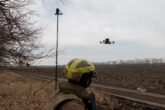October 24, 2025
Is the U.S. Ready for War with China?
This article was originally published in Foreign Policy.
Imagine China launching an invasion of Taiwan, and the United States decides to come to the island’s defense. Following the Pentagon’s doctrine and operational concepts for fighting such a war, the U.S. Navy and Air Force launch thousands of long-range missiles against Chinese ships, command centers, and logistics hubs. In the opening strikes alone, more than 33,000 precision-guided munitions target over 8,500 locations. Cyberattacks decimate Chinese military networks and paralyze the leadership. Beijing is forced to retreat or face defeat in what appears to be a swift, decisive U.S. success. Few U.S. lives are lost in this rapid, technology-driven triumph.
U.S. military planners are caught in an impossible dilemma. By continuing to focus on the kind of war they’ve always planned for—a rapid, decisive military campaign to paralyze Chinese forces and their leadership—they are increasing the risk of that leadership seeing no way out but escalation.
If this seems like the ideal scenario to you, you’d be wrong. For as precision strikes destroy Chinese missile launchers, command centers, and communications networks, Beijing’s military leaders face cascading military failures even as they are isolated by degraded communications. In a moment of panic about the rapid success of their adversary, the Chinese leadership may well consider vertical escalation—the use of nuclear weapons—before its remaining capabilities are eliminated. Beijing might authorize a demonstration nuclear strike over open waters as a signal of resolve and as an attempt to halt U.S. operations. It is then unclear whether Washington will interpret such a demonstration as justification for preemptive nuclear strikes against remaining Chinese capabilities.
Read the full article on Foreign Policy.
More from CNAS
-
Indo-Pacific Security / Transatlantic Security
Why the U.S. Should Unlock Allied CooperationAmerica’s allies are cooperating in a growing variety of domains. In their recent Foreign Affairs piece, former NATO Ambassador Julie Smith and former National Security Counci...
By Andrea Kendall-Taylor & Jim Townsend
-
Drones: Who Is Making the New Weapons of War?
From Ukraine and Russia to Gaza and Sudan, drones have become a key weapon of war. Which companies are making them, and profiting from this rapidly expanding but controversial...
By Stacie Pettyjohn
-
Who Will Lead on Military AI, the Government or Industry?
The military is going to use artificial intelligence. But while planners in the government may have an idea of the best way forward, can they truly lead, or will industry stee...
By Josh Wallin
-
Indo-Pacific Security / Technology & National Security
CNAS Insights | The Cost of Silence on China’s Cyber AggressionJust weeks before the much anticipated meeting between President Donald Trump and General Secretary Xi Jinping, the United States discovered yet another major China-backed cyb...
By Morgan Peirce




